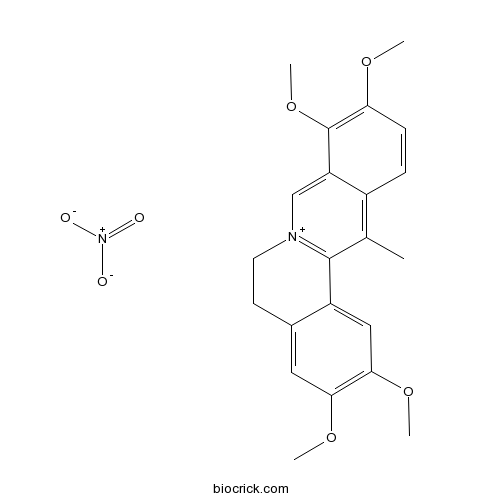Dehydrocorydaline nitrateCAS# 13005-09-9 |

Quality Control & MSDS
3D structure
Package In Stock
Number of papers citing our products

| Cas No. | 13005-09-9 | SDF | Download SDF |
| PubChem ID | 92043243 | Appearance | Powder |
| Formula | C22H24N2O7 | M.Wt | 428.44 |
| Type of Compound | Alkaloids | Storage | Desiccate at -20°C |
| Solubility | Soluble in Chloroform,Dichloromethane,Ethyl Acetate,DMSO,Acetone,etc. | ||
| Chemical Name | 2,3,9,10-tetramethoxy-13-methyl-5,6-dihydroisoquinolino[2,1-b]isoquinolin-7-ium;nitrate | ||
| SMILES | CC1=C2C=CC(=C(C2=C[N+]3=C1C4=CC(=C(C=C4CC3)OC)OC)OC)OC.[N+](=O)([O-])[O-] | ||
| Standard InChIKey | CZZFYGAXGATDNG-UHFFFAOYSA-N | ||
| Standard InChI | InChI=1S/C22H24NO4.NO3/c1-13-15-6-7-18(24-2)22(27-5)17(15)12-23-9-8-14-10-19(25-3)20(26-4)11-16(14)21(13)23;2-1(3)4/h6-7,10-12H,8-9H2,1-5H3;/q+1;-1 | ||
| General tips | For obtaining a higher solubility , please warm the tube at 37 ℃ and shake it in the ultrasonic bath for a while.Stock solution can be stored below -20℃ for several months. We recommend that you prepare and use the solution on the same day. However, if the test schedule requires, the stock solutions can be prepared in advance, and the stock solution must be sealed and stored below -20℃. In general, the stock solution can be kept for several months. Before use, we recommend that you leave the vial at room temperature for at least an hour before opening it. |
||
| About Packaging | 1. The packaging of the product may be reversed during transportation, cause the high purity compounds to adhere to the neck or cap of the vial.Take the vail out of its packaging and shake gently until the compounds fall to the bottom of the vial. 2. For liquid products, please centrifuge at 500xg to gather the liquid to the bottom of the vial. 3. Try to avoid loss or contamination during the experiment. |
||
| Shipping Condition | Packaging according to customer requirements(5mg, 10mg, 20mg and more). Ship via FedEx, DHL, UPS, EMS or other couriers with RT, or blue ice upon request. | ||
| Description | 1. Dehydrocorydaline(DHC) not only inhibits antibody-mediated allergic reactions but also influences cell-mediated allergic reactions, and the inhibitory effect of Corydalis Tuber on allergic reactions may be partially attributed to DHC. 2. Dehydrocorydaline can inhibit elevated mitochondrial membrane potential in lipopolysaccharide-stimulated macrophages. 3. Dehydrocorydaline has antinociceptive effects in mouse models of inflammatory pain, the effects involve the opioid receptor and inflammatory cytokines. 4. Dehydrocorydaline has anti-inflammatory activity. |
| Targets | IL Receptor |

Dehydrocorydaline nitrate Dilution Calculator

Dehydrocorydaline nitrate Molarity Calculator
| 1 mg | 5 mg | 10 mg | 20 mg | 25 mg | |
| 1 mM | 2.334 mL | 11.6702 mL | 23.3405 mL | 46.681 mL | 58.3512 mL |
| 5 mM | 0.4668 mL | 2.334 mL | 4.6681 mL | 9.3362 mL | 11.6702 mL |
| 10 mM | 0.2334 mL | 1.167 mL | 2.334 mL | 4.6681 mL | 5.8351 mL |
| 50 mM | 0.0467 mL | 0.2334 mL | 0.4668 mL | 0.9336 mL | 1.167 mL |
| 100 mM | 0.0233 mL | 0.1167 mL | 0.2334 mL | 0.4668 mL | 0.5835 mL |
| * Note: If you are in the process of experiment, it's necessary to make the dilution ratios of the samples. The dilution data above is only for reference. Normally, it's can get a better solubility within lower of Concentrations. | |||||

Calcutta University

University of Minnesota

University of Maryland School of Medicine

University of Illinois at Chicago

The Ohio State University

University of Zurich

Harvard University

Colorado State University

Auburn University

Yale University

Worcester Polytechnic Institute

Washington State University

Stanford University

University of Leipzig

Universidade da Beira Interior

The Institute of Cancer Research

Heidelberg University

University of Amsterdam

University of Auckland

TsingHua University

The University of Michigan

Miami University

DRURY University

Jilin University

Fudan University

Wuhan University

Sun Yat-sen University

Universite de Paris

Deemed University

Auckland University

The University of Tokyo

Korea University
- GSK1324726A
Catalog No.:BCC4038
CAS No.:1300031-52-0
- I-BET151 (GSK1210151A)
Catalog No.:BCC4476
CAS No.:1300031-49-5
- Quinine
Catalog No.:BCN2341
CAS No.:130-95-0
- Quinine HCl
Catalog No.:BCN2262
CAS No.:130-89-2
- Protopine
Catalog No.:BCN6165
CAS No.:130-86-9
- Thioridazine HCl
Catalog No.:BCC3869
CAS No.:130-61-0
- 1,4-Naphthoquinone
Catalog No.:BCN8420
CAS No.:130-15-4
- Senecionine
Catalog No.:BCN2129
CAS No.:130-01-8
- Iloperidone hydrochloride
Catalog No.:BCC4212
CAS No.:1299470-39-5
- Dapoxetine HCl
Catalog No.:BCC5064
CAS No.:129938-20-1
- Amicarbazone
Catalog No.:BCC5464
CAS No.:129909-90-6
- MC 976
Catalog No.:BCC1734
CAS No.:129831-99-8
- Mafenide Acetate
Catalog No.:BCC5236
CAS No.:13009-99-9
- Lomustine
Catalog No.:BCC4794
CAS No.:13010-47-4
- (+)-Igmesine hydrochloride
Catalog No.:BCC5902
CAS No.:130152-35-1
- Ergosterol glucoside
Catalog No.:BCN7327
CAS No.:130155-33-8
- Torilolone
Catalog No.:BCN6659
CAS No.:13018-09-2
- Torilin
Catalog No.:BCN6611
CAS No.:13018-10-5
- Cirsimarin
Catalog No.:BCN6821
CAS No.:13020-19-4
- N-(4-Hydroxyphenylacetyl)spermine
Catalog No.:BCC6594
CAS No.:130210-32-1
- Acerogenin G
Catalog No.:BCN7328
CAS No.:130233-83-9
- 3'-Demethoxypiplartine
Catalog No.:BCN4021
CAS No.:130263-10-4
- PD 135158
Catalog No.:BCC7431
CAS No.:130285-87-9
- Rubiarbonol B
Catalog No.:BCN6159
CAS No.:130288-60-7
Dehydrocorydaline inhibits elevated mitochondrial membrane potential in lipopolysaccharide-stimulated macrophages.[Pubmed:21575743]
Int Immunopharmacol. 2011 Sep;11(9):1362-7.
Activated macrophages play a critical role in the pathogenesis of numerous diseases by producing pro-inflammatory cytokines such as interleukin (IL)-1beta and IL-6. While the mechanisms of bacterial component recognition and signal transduction have been well investigated, viability regulation in activated macrophages remains unclear. We screened herbal ingredients to find an agent that reduces the viability of lipopolysaccharide (LPS)-stimulated macrophages and observed that dehydrocorydaline, a component of Corydalis yanhusuo, reduced the viability of macrophage-derived RAW264.7 cells and primary macrophages in the presence of LPS. Dehydrocorydaline inhibited the elevation of mitochondrial membrane potential and induced ATP depletion in LPS-stimulated macrophages but neither affected basal mitochondrial membrane potential nor ATP content in non-stimulated macrophages. Dehydrocorydaline also prevented increased concentrations of IL-1beta and IL-6 in culture media of LPS-stimulated macrophages. Mode of dehydrocorydaline action indicates that elevated mitochondrial membrane potential may be a novel target to specifically reduce viability and suppress cytokine production in LPS-stimulated macrophages.


